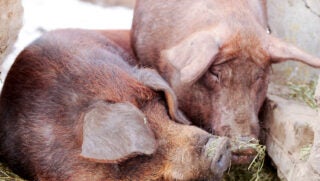There are hundreds of breeds of cattle recognized worldwide. Just like with different dog breeds, different types of cattle each have unique traits and attributes. For example, dairy cattle are selected for their milk production traits, while beef cattle are selected for beef production traits. Some cattle breeds also fall in the middle and are called dual-purpose breeds.
Certain breeds rise to the top in different areas of the world. In the United States, there are seven main dairy cattle breeds that make up most of the nation’s nearly 9.4 million-cow national dairy herd.
Holstein
The Holstein (or Holstein-Friesian) is the most popular dairy breed, comprising around 90 percent of cows on U.S. dairy farms. They are known for their distinctive black and white pattern. And their spot pattern is like a fingerprint — no two are exactly alike.
Holsteins originated in the Netherlands and were imported to the U.S. starting in the 1600s. By the late 1800s, official herdbooks were established and merged into a national association. Holsteins are known for producing a greater volume of milk than most other dairy breeds. Mature Holsteins are also one of the largest cows, typically weighing around 1,500 pounds!
Red and White
While the black-and-white Holsteins are the most popular, Holstein cows can also be red and white, which is caused by a recessive gene. The Red and White Holstein is one of the newest breeds, being recognized in the U.S. in 1964. This breed has similar characteristics to its black-and-white cousins, with the added bonus of increased heat tolerance.
Jersey
The Jersey is the smallest major dairy cattle breed, weighing in at between 800 to 1,200 pounds when mature. Jersey cows range in color from dark to light fawn, with or without white marks. They are known for their friendly personality, heat tolerance, feed efficiency, and producing rich milk, high in butterfat, which is great for making cheese and ice cream (yum!).
The Jersey originates from the Isle of Jersey in the English Channel. The American Jersey Cattle Association is the oldest dairy breed association in the U.S., having been established in 1868.
Brown Swiss
Brown Swiss originate from the Swiss Alps and are considered the oldest dairy cattle breed, having appeared around 4000 B.C. They vary in color from silver to dark brown, and they are large in size, similar to a Holstein, but typically bigger boned. They are known for their docile temperament and high protein-to-fat ratio in their milk.
Guernsey
The Guernsey is also called the “Golden Guernsey” for the distinct golden color of their milk, which is caused by high levels of beta-carotene, a source of vitamin A. They are also known for their rich, creamy milk.
They originated from the Isle of Guernsey in the English Channel. Guernseys are typically a golden fawn color with white areas across their body and weigh around 1,200 pounds.
Ayrshire
Ayrshire cattle were first imported from the county of Ayr in Scotland to the United States in the 1800s. They are rusty-red and white in color and well-known for their vigor and ability to adapt to the environment — and they can be found around the world. They are a mid-sized breed, weighing around 1,200 pounds.
Milking Shorthorn
The Milking Shorthorn originates from Great Britain. It is a very versatile breed as it was originally a dual-purpose breed bred for both milk and beef production. Through breeding for different characteristics, the Milking Shorthorn dairy breed focuses more on milk production rather than the beef traits of the Shorthorn. Milking Shorthorn cattle are around 1,400 pounds when fully grown and range in color from red and white to roan.
The above seven breeds are considered the major U.S. dairy breeds, although other dairy breeds and crossbreeds (mixed heritage) can be found as well. These include Dutch Belted, American Lineback, Montebeliarde, Milking Devon, Normande, Norwegian Red, and many more!
Michelle Miller, the Farm Babe, is a farmer, public speaker and writer who has worked for years with row crops, beef cattle, and sheep. She believes education is key in bridging the gap between farmers and consumers.



